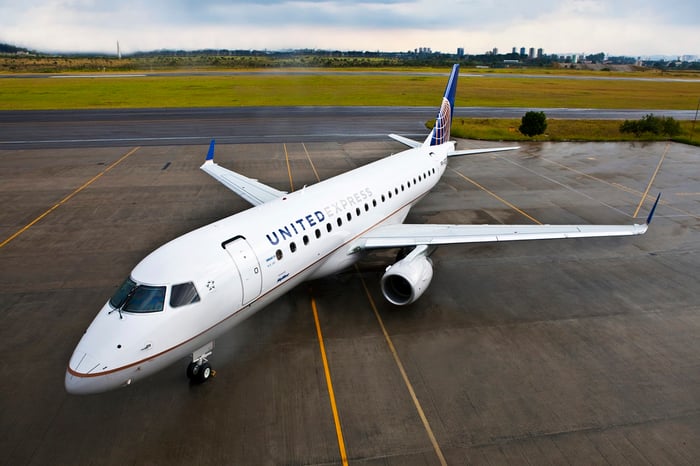Embraer (ERJ -0.74%) found itself in a sticky situation entering 2013. The Brazilian aerospace company delivered 106 commercial jets during 2012, yet it ended the year with a backlog of just 185 firm orders for its E-Jets. Typically, commercial aircraft manufacturers like to have several years' worth of production lined up in their firm backlogs.
However, since then, Embraer has capitalized on a wave of aircraft replacements in the U.S. regional airline sector. This has enabled it to keep output steady as it transitions the bulk of its production to its next-generation E2-series jets. Embraer continued its roll of success at this week's Paris Air Show, as United Continental (UAL 5.50%) ordered more E175s.
A dominant performance
Since the middle of 2013, Embraer has delivered just over 400 E175 jets to regional airlines operating for the four major U.S. airlines that have regional affiliates. During the same period, Bombardier -- its only current competitor in the market for large regional jets -- has delivered just 113 new regional jets in the U.S.
Success in the U.S. regional airline sector has kept Embraer afloat recently. Over the past six years, more than two-thirds of deliveries for its E-Jets family have gone to U.S. regional airlines. Meanwhile, Bombardier was forced to cut output of its CRJ family jets from an average of 50 per year between 2014 and 2016 to just 26 jets in 2017 and 20 last year.

U.S. regional airlines have added hundreds of E175s to their fleets since 2013. Image source: United Airlines.
Embraer's order advantage has been growing in recent years. Looking forward, Embraer ended the first quarter with 171 firm orders for E175s in the U.S. market, largely thanks to a deal for 100 E175s with Republic Airways that was finalized late last year. By contrast, Bombardier had just 27 remaining firm orders from U.S. airlines for its competing CRJ-900 as of the end of the first quarter.
Embraer lands another order
On Monday, Embraer announced that United Airlines had placed a new firm order for 20 E175s, to be operated in a spacious 70-seat configuration by the airline's regional partners. United also has options for an additional 19 E175s. The first aircraft under this deal will be delivered in the second quarter of 2020.
This sale keeps Embraer's backlog looking quite solid for the next few years. As of the end of the first quarter, Embraer had firm orders for 206 current-generation E-Jets along with 153 next-generation E190-E2 and E195-E2 models.
Nearly all of the current-generation E-Jets -- and dozens of E2-series jets -- will be delivered between now and 2021. Based on Embraer's historical production rate of about 100 commercial jets per year, the vast majority of its delivery slots have already been filled during that period. (In 2019 specifically, Embraer expects to deliver only 85 to 95 commercial jets.)
Embraer has delivered at least 24 commercial jets since the beginning of the second quarter, bouncing back from a weak first quarter, when it delivered just 11. The firm part of United's order will restock the backlog for most of the aircraft delivered this quarter, while the options would add to Embraer's order book.
Embraer has this market locked down
Earlier this week, I noted that Mitsubishi Aircraft Corporation's attempt to break into the U.S. regional airline market with the SpaceJet M100 is likely to fail. While the SpaceJet M100 will be cheaper to operate than the comparable, older-technology E175, it is coming too late.
This week's United Airlines order was just one more blow to Mitsubishi's ambitions. Indeed, it's particularly remarkable that United decided to double down on the E175 just a few days after Mitsubishi took the wraps off its state-of-the-art competitor.
Due to pilot contracts that limit the number of large regional jets the three big U.S. network carriers can use, there's only room for about 1,000 (or at most 1,100) 70- to 76-seat regional jets in the U.S. As noted above, Embraer and Bombardier have combined to deliver more than 500 new jets in this size range in the U.S. just since mid-2013, with nearly 200 firm orders remaining. Thus, there's very little room for the market to grow and there will be very few large regional jets in need of replacement during the decade after the SpaceJet M100 enters service in 2023.
Embraer's E175 offers airlines an excellent combination of low acquisition costs, manageable operating costs, great reliability, and high passenger comfort. Airlines don't want to mess with this proven formula for success. As a result, the E175 is likely to be the primary aircraft for U.S. regional airlines well into the 2030s.





